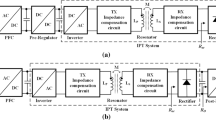Abstract
In inductive power transfer (IPT) systems for electric vehicle applications, the coupling coefficient k and self-inductances of the pads can vary depending on the misalignment and vertical distance due to the presence of loosely coupled pads. Furthermore, the operating frequencies of IPT systems are restricted by a Society of Automotive Engineers standard. These frequencies lead to increases in volt-ampere rating and switching losses. Therefore, this paper proposes a control method for operation in a zero voltage switching region close to the zero phase angle frequency for a low volt-ampere rating considering k and the self-inductance variation in a limited operating frequency range. A mathematical analysis is performed, and the critical coupling coefficients of the proposed control are derived. Simulation and experimental results using a 3.3 kW IPT prototype are presented so as to verify the numerical analysis.

















Similar content being viewed by others
References
Jang Y, Jovanovic MM (2003) A contactless electrical energy transmission system for portable-telephone battery chargers. IEEE Trans Ind Electron 50(3):520–527
Beh HZZ, Covic GA, Boys JT (2015) Wireless fleet charging system for electric bicycles. IEEE J Emerg Sel Top Power Electron 3(1):75–86
Chen C, Wong SC, Tse CK, Ruan X (2009) Analysis, design, and control of a transcutaneous power regulator for artificial hearts. IEEE Trans Biomed Circuits Syst 3(1):23–31
Covic GA, Boys JT (2013) Inductive power transfer. Proc IEEE 101(6):1276–1289
Patil D, McDonough MK, Miller JM, Fahimi B, Balsara PT (2018) Wireless power transfer for vehicular applications: overview and challenges. IEEE Trans Transp Electrific. 4(1):3–37
Cirimele V, Diana M, Freschi F, Mitolo M (2018) Inductive power transfer for automotive applications state-of-the-art and future trends. IEEE Trans Ind Appl 54(5):4069–4079
Gao Y, Ginart A, Farley KB, Tse ZTH (2016) Misalignment effect on efficiency of wireless power transfer for electric vehicles. In: Proc. IEEE Appl. Power Electron. Conf. Expo., pp 3526–3528
Carlson RW, Normann B (2014) Test results of the PLUGLESS inductive charging system from Evatran Group, Inc. SAE Int J Altern Powertrains 3(1):64–71
Zhang Z, Chau KT (2015) Homogenous wireless power transfer for move and charge. IEEE Trans Power Electron 30(11):6213–6220
Wang C-S, Covic GA, Stielau OH (2004) Power transfer capability and bifurcation phenomena of loosely coupled inductive power transfer systems. IEEE Trans Ind Electron 51(1):148–157
Zhang W, Mi CC (2016) Compensation topologies of high-power wireless power transfer systems. IEEE Trans Veh Technol 65(6):4768–4778
Wang C-S, Covic GA, Stielau OH (2001) ‘General stability criterions for zero phase angle controlled loosely coupled inductive power transfer systems’. Proc IEEE Ind Electron Conf 2:1049–1054
Fu M, Ma C, Zhu X (2014) A cascaded boost-buck converter for high efficiency wireless power transfer systems. IEEE Trans Ind Inform 10(3):1972–1980
Yilmaz M, Krein PT (2013) Review of battery charger topologies, charging power levels, and infrastructure for plug-in electric and hybrid vehicles. IEEE Trans Power Electron 28(5):2151–2169
Wireless Power Transfer for Light-Duty Plug-In/Electric Vehicles and Alignment Methodology, Standard SAEJ2954, 2017. http://standards.sae.org/j2954_201711/. Accessed 27 Nov 2017
Wang C-S, Covic GA, Stielau OH (2004) Investigating an LCL load resonant inverter for inductive power transfer applications. IEEE Trans Power Electron 19(4):995–1002
Wu HH, Gilchrist A, Sealy KD, Bronson D (2012) A high efficiency 5 kW inductive charger for EVs using dual side control. IEEE Trans Ind Inf 8(3):585–595
Chang-Yu H, James JE, Covic GA (2015) Design considerations for variable coupling lumped coil systems. IEEE Trans Power Electron 30(2):680–689
Jiang Y, Wang L, Wang Y, Liu J, Li X, Ning G (2019) Analysis, design and implementation of accurate ZVS angle control for EV’s battery charging in wireless high power transfer. IEEE Trans Ind Electron 66(5):4075–4085
Boys JT, Huang CY, Covic GA (2008) Single-phase unity power-factor inductive power transfer system. In: 2008 IEEE power electronics specialists conference. IEEE, Rhodes, pp 3701–3706
Borage M, Tiwari S, Kotaiah S (2005) Analysis and design of an LCL-T resonant converter as a constant-current power supply. IEEE Trans Ind Electron 52:1547–1554
Steigerwald RL (1988) A comparison of half-bridge resonant converter topologies. IEEE Trans Ind Electron 3(2):174–182
Acknowledgements
This work was supported by “Human Resources Program in Energy Technology” of the Korea Institute of Energy Technology Evaluation and Planning (KETEP), granted financial resource from the Ministry of Trade, Industry & Energy, Korea. (No. 20184030202190). This work was supported by the Korea Institute of Energy.
Author information
Authors and Affiliations
Corresponding author
Additional information
Publisher's Note
Springer Nature remains neutral with regard to jurisdictional claims in published maps and institutional affiliations.
Rights and permissions
About this article
Cite this article
Byun, J., Kim, M., Joo, D. et al. Frequency and Phase-Shift Control of Inductive Power Transfer for EV Charger with LCCL-S Resonant Network Considering Misalignment. J. Electr. Eng. Technol. 14, 2409–2419 (2019). https://doi.org/10.1007/s42835-019-00297-5
Received:
Revised:
Accepted:
Published:
Issue Date:
DOI: https://doi.org/10.1007/s42835-019-00297-5




